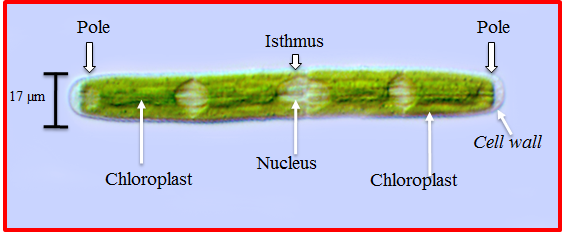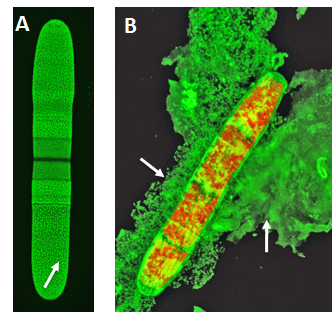Research
Approximately 470–500 million years ago, a freshwater green alga emerged onto land and ultimately gave rise to modern-day land plants. This event represents one the most most important keystone events in the history of our planet. Plants changed the biogeogeochemistry of the planet, yielded conditions for successful colonization of land by other kingdoms of life (e.g. animals, fungi) and changed the course of human evolution. Plants provide us with food, medicines, clothing, building materials and fuels to support our electricity needs and transportation.
Along with the possession of photosynthetic organelles (e.g. chloroplasts), the most distinguishing feature of a plant cell is the cell wall. The wall is a covering around the plant cell that provides the plant cell with physical protection, expansion control, rigidity, a means for absorption and transport of water and minerals and a conduit for communication with the external biotic and abiotic surroundings. The cell wall is made up of various polymers including cellulose, pectins, hemicelluloses and various proteins, along with water and various inorganics. Cell-wall polymers represent some of the most abundant biochemicals produced on the planet each year and are the bases for agriculture, textiles, building materials and fuels. Plant cells devote much of the photosynthetic carbon that they make into the production of the cell wall, and it is estimated that between 20% and 30% of the genome is devoted to the synthesis and maintenance of the cell wall. Furthermore, the cell wall is a “living” entity in that it is dynamically modulating to cell expansion, division and development. As one would imagine, the cell wall is a major focal point of study by biologists, chemists and environmental scientists. Presently, molecular, biochemical and cell biology-based studies are revealing much about the cell wall and its components. One of the major practical difficulties with such studies is that it is often difficult to resolve specific structures and events of a single cell that is part of a complex multicellular tissue or organ. However, a unicellular model plant system has emerged for the study of plant cell walls and other areas of plant research, Penium margaritaceum.
History of Penium Research
Penium margaritaceum was first classified: (Ehrenb.) ex Brébisson in Ralfs 1848
Taxonomic description of the genus Penium: Cells solitary, short-cylindric to elongate-cylindric (length 19–450 um; length 2–35 times width), straight, with broadly rounded or truncate ends; shallow median constriction sometimes present. Cell wall with or without girdle bands, smooth or with striae, pores, granules or spines. Ultrastructurally cell wall two-layered, with perforated outer layer and continuous inner layer. Cell wall sometimes brown, often with different wall sections different shades of brown. Two (rarely four) chloroplasts per cell, axial and stellate in end view (spiralling parietal bands in one species) with one to two axial pyrenoids. Terminal vacuoles with small crystals in some species. Nucleus at middle between chloroplasts. Asexual reproduction by transverse cell division. Some species divide only at median suture and produce new semicell on each daughter cell. Other species from girdle band on new semicell. Sexual reproduction by conjugation. Gametangia come together within mucilage envelope; gametes fuse between gametangial. Zygospores single or paired, spherical to ellipsoid (occasionally angular), usually smooth-walled. Mesopore wall of P. silvae-nigrae corrugated or finely punctate. Penium cosmopolitan; usually in acidic, oligotrophic ponds or lakes or in sphagnum bogs. Emend. Kouwets & Coesel 1984: 561. http://www.algaebase.org/search/genus. To learn more about the taxonomy of Penium, please see: 1) Brook, A.J. & Johnson, L.R. (2002). Order Zygnematales. In: The Freshwater Algal Flora of http://www.algaebase.org/search/genus
To learn more about the taxonomy of Penium, please see:
1) Brook, A.J. & Johnson, L.R. (2002). Order Zygnematales. In: The Freshwater Algal Flora of the British Isles. An identification guide to freshwater and terrestrial algae. (John, D.M., Whitton, B.A. & Brook, A.J. Eds), pp. 479–593. Cambridge: Cambridge University Press.
2) http://img.algaebase.org/pdf/AC100CF1118e535FD6GHn379D9BA/ britishdesmidiea1848ralf.pdf.
Penium margaritaceum

Penium margaritaceum is an elongate cylindrical desmid with rounded poles. The cell measures 17 µm in width and has a length that ranges from 150 µm to 250 µm. The central region of the cell or isthmus contains the nucleus and is surrounded by two to four chloroplasts. The isthmus is the focal point of cell wall deposition during expansion. The cell is surrounded by a primary cell wall.
Penium's cell wall—a focal point of research

The extracellular matrix of Penium:
Penium possesses a primary cell wall that consists of many wall polymers also found in land
plants including cellulose, pectins, arabino-galactan proteins and extension. Penium also secretes a jelly-like mucilage outside of the cell wall that functions in gliding
motility and in “encapsulating” the cell.
“A” is a Confocal Laser Scanning Microscope (CLSM) image of the outer pectin layer of the cell wall labeled with the anti-pectin nntibody, JIM5.
“B” is a CLSM image of the the mucilage labeled with an anti-mucilage antibody.